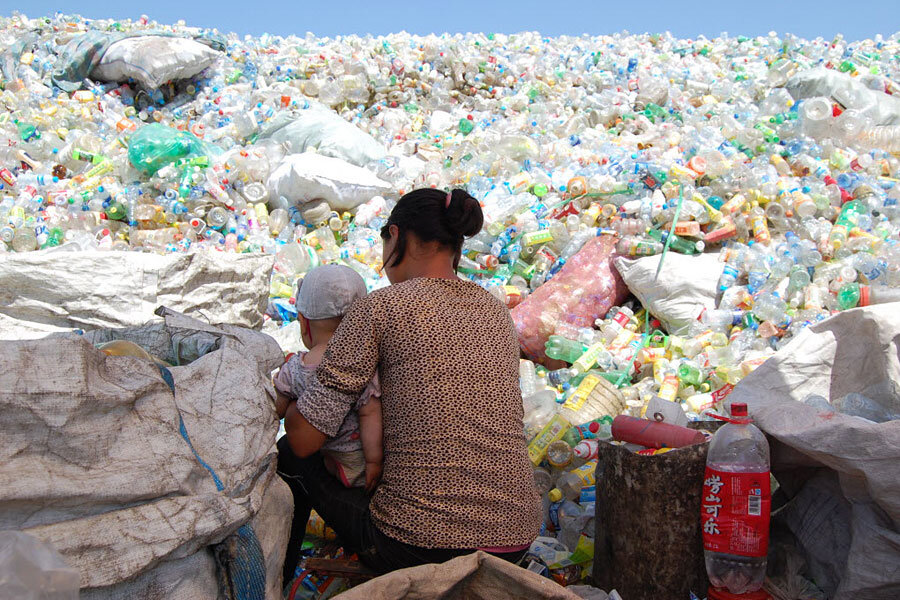Researchers find plastic-eating bacteria in recycling plant
Loading...
Plastic is everywhere around us. We drink out of plastic cups, buy disposable water bottles, unwrap new electronics from plastic packaging, take home plastic shopping bags, and even wear plastic in polyester fabrics.
Some 311 million tons of plastic is produced across the globe annually, and just 10 percent makes it back to a recycling plant. The rest ends up in landfills, or as litter on land or in the ocean, where it remains for decades and longer.
As for the plastic that has been recycled, it has given rise to an unintended side effect: A team of scientists searching through sediments at a plastic bottle recycling plant in Osaka, Japan have found a strain of bacteria that has evolved to consume the most common type of plastic.
Ideonella sakaiensis 201-F6 can degrade poly (ethylene terephthalate), commonly called PET or PETE, in as little as six weeks, they report in a new paper published Thursday in the journal Science.
Common uses of PET include polyester fibers, disposable bottles, and food containers. The last two are typically labelled with a No. 1 inside a recycling symbol.
But this new paper doesn't mean you should ditch your reusable water bottles in favor of a tray of disposable ones, or that we're going to inject this bacteria into landfills tomorrow. This study simply evaluated if the bacteria in question could degrade PET and was conducted under laboratory conditions.
"We hope this bacterium could be applied to solve the severe problems by the wasted PET materials in nature," Kohei Oda, one of the study authors, tells The Christian Science Monitor in an email. But "this is just the initiation for application." More research has to be done in order to make this a practical solution to plastic pollution.
But could this sort of fix work in theory?
"[Plastics] have been engineered for cost and for durability, or longevity," says Giora Proskurowski, an oceanographer at the University of Washington who studies plastic debris in the ocean but was not part of this study, in a phone interview with the Monitor. But he's hopeful that this research could yield further studies and technologies to mitigate the problem.
The durability of plastic isn't the only challenge this potential fix faces. Microbes are like teenagers, Christopher Reddy, a senior scientist at Woods Hole Oceanographic Institution who studies environmental pollution and was not part of this study, explains in an interview with the Monitor.
"You can tell them to clean the garage over the weekend but they're going to do it on their own timescale, they're going to do it when they want, they're going to pick the easiest thing to do and they're likely going to leave you more frustrated than you think," he explains the metaphor. Similarly, you can't rely on microbes to break down compounds. "Don't rely on microbes to clean the environment."
Dr. Reddy says that has a lot to do with the environment outside the lab. In the experiment, he says, the researchers controlled the situation so the bacteria ate the plastic, but in nature, they would have many options for food.
Also, if I. sakaiensis 201-F6 were to be applied, it would likely only help plastic pollution on land. PET particles are denser than water, so they tend to sink down into the sediment. The trillions of tons of plastic particles amassing in the oceans are other types of plastics, types for which this bacteria probably lacks an appetite. Also, Dr. Proskurowski says, marine organisms have evolved to withstand the saltwater and sunlight that sediment-dwelling organisms might not.
Still, perhaps this bacteria could be harnessed to accelerate degradation of plastics that make it to a landfill, he says.
But this study does show that "the environment is evolving and you get the microbes evolving along with that as well," Proskurowski says. "These are evolving systems."
Neither Proskurowski nor Reddy were surprised that the researchers found an organism that can consume PET.
"I'm surprised it's taken this long. I've been waiting for results like this," Proskurowski says.
"Nature is incredibly wily, microbes are incredibly wily," Reddy says. "Microbes are very good eaters."
This is not the first time researchers have found an organism that will eat trashed plastic. Last year engineers at Stanford University found a mealworm that can eat styrofoam. And in that case, it was not the animal's digestion that broke down the styrofoam, but bacteria it its gut.








